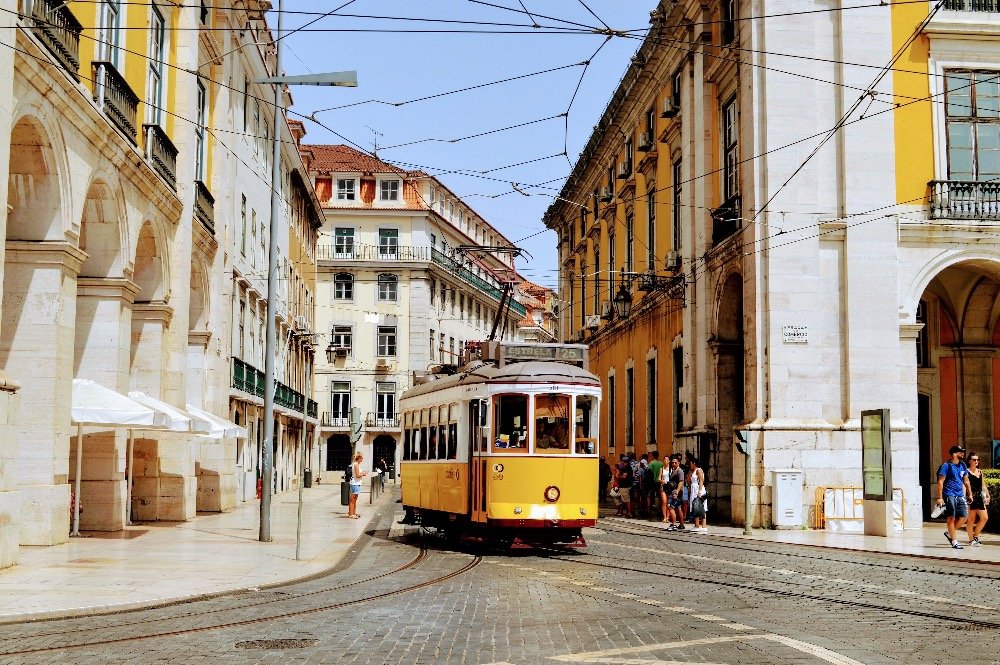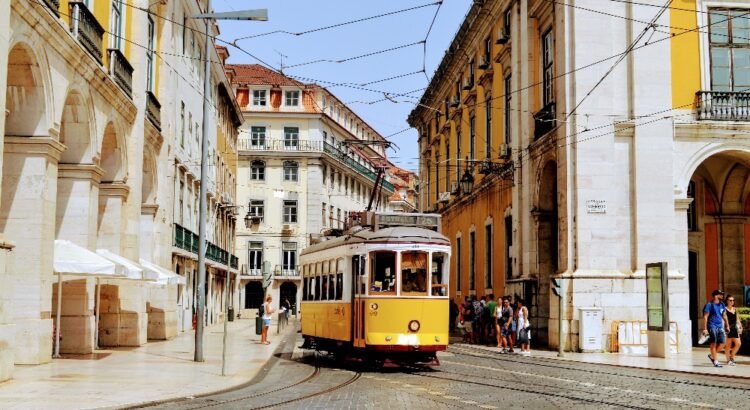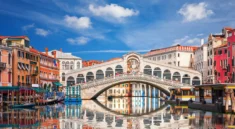
Perched across seven hills that overlook the shimmering Tagus River, Lisbon is one of Europe’s most charismatic and soulful cities. As the capital of Portugal, Lisbon is a city where the past and present dance in harmony, where narrow cobblestone streets echo with the mournful melodies of fado, and where sunset hues paint the facades of historic buildings. Known for its iconic yellow trams, vibrant tiles, scenic viewpoints, and an atmosphere that feels both lively and contemplative, Lisbon offers an enchanting blend of history, culture, music, and color.
As travelers wander through its maze-like alleyways, sip coffee in centuries-old cafés, or watch the world go by from a miradouro (viewpoint), they discover a city deeply rooted in tradition yet effortlessly modern. Lisbon is not just a place you visit; it is a feeling—timeless, soulful, and radiant.
A Journey Through the City’s Chromatic Charm
Lisbon is perhaps most instantly recognizable by its colors. The cityscape is awash in terracotta rooftops, sun-faded pinks, pastel blues, and golden yellows. Add to this the azulejos—the hand-painted ceramic tiles that cover buildings, fountains, and benches—and you have a place that feels like a living art installation.
These tiles, often featuring floral patterns, religious motifs, or historical scenes, have adorned the city for centuries. They don’t merely decorate; they tell stories, preserving Lisbon’s rich and turbulent past.
In neighborhoods like Alfama, Bairro Alto, and Mouraria, the colors feel almost organic—reflecting the warmth of the sun, the salt of the sea breeze, and the spirit of the people.
The Melancholic Soul: Fado Music
If Lisbon had a voice, it would sing fado. Recognized by UNESCO as an Intangible Cultural Heritage, fado is a genre of Portuguese music that conveys “saudade”—a uniquely Portuguese term evoking longing, nostalgia, and bittersweet emotion. It is both a lament and a celebration, expressing the joys and sorrows of life.
Origins of Fado
Fado was born in the early 19th century in the working-class neighborhoods of Lisbon, particularly in Alfama and Mouraria. Its themes often revolve around lost love, poverty, the sea, and fate—a reflection of the hardships and resilience of the people.
Initially performed in taverns and brothels, fado was shaped by sailors, travelers, and locals. Over time, it gained recognition as one of Portugal’s most important cultural expressions.
Where to Experience Fado
In Lisbon today, the best way to experience fado is in a traditional fado house—an intimate restaurant or venue where live performances accompany dinner. Places like Clube de Fado, Casa de Linhares, and Tasca do Chico offer unforgettable evenings filled with emotion, food, and music.
A typical performance involves a solo singer—often dressed in black—accompanied by the Portuguese guitarra, a 12-string instrument with a distinct, sorrowful twang. The room falls silent as the singer begins, their voice carrying the weight of centuries and the soul of the city.
The Iconic Trams: Lisbon’s Moving Landmarks
Lisbon’s famous yellow trams, particularly Tram 28, have become one of the city’s most recognizable symbols. Introduced in the early 20th century, these charming electric trams still follow the old, winding routes through the steep and narrow streets of the historic neighborhoods.
Tram 28: A Ride Through Time
No visit to Lisbon is complete without a ride on Tram 28, which connects Martim Moniz to Campo de Ourique. As it rumbles through neighborhoods like Graça, Alfama, and Baixa, passengers are treated to views of ancient cathedrals, castles, vintage storefronts, and hilltop panoramas.
Riding the tram is not only practical for navigating Lisbon’s hills; it is an immersive cultural experience. The wooden interiors, the creaking motion, the conversations in multiple languages—it’s a journey both literal and poetic.
Alfama: The Heart of Old Lisbon
The Alfama district is the oldest in Lisbon and the cradle of fado. Here, time seems to stand still. Labyrinthine alleyways twist and turn unexpectedly, revealing secret courtyards, laundry hanging on lines, and neighbors chatting from window to window.
During the Festas de Lisboa in June, Alfama bursts into life with music, food stalls, and colorful decorations. Yet even outside festival season, the area hums with quiet, everyday beauty.
The Lisbon Cathedral (Sé de Lisboa) and the Castelo de São Jorge, with its panoramic views, crown this district and remind visitors of Lisbon’s ancient and strategic importance.
Miradouros: Windows to the City
Given Lisbon’s hilly terrain, it offers some of the best city viewpoints in Europe. Known as miradouros, these scenic terraces provide unforgettable vistas of rooftops, church spires, and the Tagus River.
Miradouro da Senhora do Monte
Located in the Graça district, this viewpoint offers a sweeping view of central Lisbon, including the castle and river. It’s less crowded than others, making it ideal for a peaceful moment of reflection.
Miradouro de Santa Catarina
Popular with locals, especially at sunset, this miradouro gives a laid-back, bohemian vibe. Street musicians often play here, and the atmosphere is relaxed and communal.
Watching the sun set over Lisbon from a miradouro is a simple yet profound joy. As the city glows gold, you understand why poets and painters have been inspired by this view for centuries.
Gastronomic Delights: A Taste of Lisbon
Lisbon is a culinary treasure trove, where traditional recipes coexist with contemporary innovation. Its food tells stories of sailors, spices, empires, and everyday life.
Pastéis de Nata
No trip to Lisbon is complete without tasting a pastel de nata, a flaky custard tart sprinkled with cinnamon. The most famous version comes from Pastéis de Belém, which has followed the original 19th-century recipe of the Jerónimos Monastery.
Seafood and Petiscos
Being a coastal city, Lisbon offers fresh seafood in abundance—grilled sardines, octopus salad, bacalhau (salt cod), and more. Petiscos, Portuguese tapas-style dishes, allow diners to sample a variety of flavors in one meal.
Pair your meal with a glass of Vinho Verde or a shot of Ginja, a cherry liqueur traditionally served in a chocolate cup.
A Rich Cultural Legacy
Lisbon’s history spans thousands of years, shaped by Romans, Moors, kings, earthquakes, and explorers.
Belém: The Age of Discoveries
In Belém, travelers step into Portugal’s glorious past. From here, ships set sail during the Age of Discoveries, changing world history. The Jerónimos Monastery, a UNESCO World Heritage site, and the Monument to the Discoveries honor this legacy.
Nearby, the Belém Tower, once a fortress and ceremonial gateway, stands proudly over the river.
Museums and Art
Lisbon is home to fascinating museums like the Museu Nacional do Azulejo, which showcases the story of Portuguese tiles, and the MAAT (Museum of Art, Architecture, and Technology), which blends futuristic design with contemporary exhibitions.
A Modern Creative City
While Lisbon is deeply historical, it also pulses with creative energy. Young artists, entrepreneurs, and digital nomads are making the city a hub of innovation and culture.
The LX Factory, a former industrial complex turned into a trendy cultural space, is filled with bookstores, art studios, restaurants, and rooftop bars. It represents Lisbon’s ability to reinvent itself while staying true to its essence.
Warm People, Slower Rhythms
Lisbon’s charm is not only in its sights and sounds, but also in its people. Lisboetas are known for being warm, helpful, and proud of their city. There’s a gentleness in how life unfolds in Lisbon—meals are savored, conversations linger, and the sea breeze always finds a way into your day.
Conclusion: A City That Sings to the Soul
Lisbon is not merely a capital—it is a canvas painted in emotion, music, light, and history. Its colorful walls, iconic trams, and haunting fado songs don’t just entertain—they speak to the soul. This is a city of layers: ancient and modern, joyful and melancholic, vibrant and serene.
To wander through Lisbon is to walk through poetry. To listen to fado is to feel a thousand stories in a single note. And to ride Tram 28 is to embrace the rhythm of a city that never forgets where it came from—even as it moves confidently toward the future.
Lisbon invites you not just to see it, but to feel it. And once you do, it stays with you forever.




